The Argala Stotram is a powerful hymn dedicated to Goddess Durga, often recited during the Chandi Path or Durga Saptashati․ Composed of 16 verses, it praises Durga’s divine aspects and seeks her blessings for protection, prosperity, and victory․ Available as a PDF in Sanskrit, it is widely revered in Hindu scripture and is accompanied by translations in multiple languages for broader accessibility․ This sacred stotram is integral to devotion, offering spiritual and material benefits to its reciters․
Overview of the Argala Stotram
The Argala Stotram is a sacred hymn dedicated to Goddess Durga, forming an integral part of the Durga Saptashati and Markandeya Purana․ Comprising 16 verses, it is traditionally recited during the Chandi Path, invoking Durga’s blessings for protection, prosperity, and victory․ The stotram is renowned for its ability to remove obstacles and negative energies, offering both spiritual and material benefits․ Available as a PDF in Sanskrit, it is widely accessible, with translations in multiple languages to cater to diverse devotees․ Its melodic recitation and deep spiritual significance make it a cornerstone of Hindu worship, particularly during festivals and ceremonies honoring Goddess Durga․
Significance of the Argala Stotram in Hindu Scripture
The Argala Stotram holds profound significance as a revered composition in Hindu scripture, particularly within the Durga Saptashati․ It is considered a powerful tool for invoking Goddess Durga’s divine energy and grace․ The stotram is believed to offer protection, remove obstacles, and grant spiritual and material success․ Its verses are deeply rooted in Vedic traditions and are often recited during sacred rituals to appease the goddess․ The stotram’s ability to ward off negative influences and bestow blessings makes it a cornerstone of Hindu devotional practices․ Its inclusion in the Markandeya Purana further highlights its importance in the broader context of Hindu religious texts․
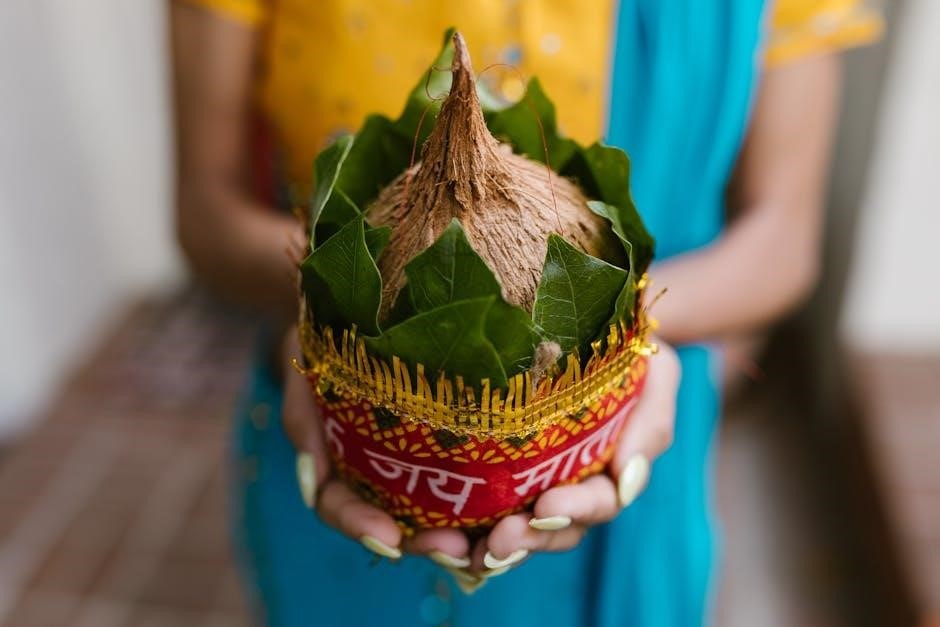
Origin and Background
The Argala Stotram originates from ancient Hindu scriptures, deeply rooted in the Markandeya Purana․ It is an integral part of the Durga Saptashati, extolling Goddess Durga’s divine prowess․ Available in Sanskrit PDF formats, it preserves its sacred essence and is widely revered for its spiritual significance․
Historical Context of the Argala Stotram
The Argala Stotram is deeply rooted in ancient Hindu scripture, specifically within the Markandeya Purana, a revered text of the Puranic tradition․ It is a continuation of the Devi Mahatmyam, a sacred hymn glorifying Goddess Durga’s divine victories․ Comprising 28 verses, the Argala Stotram is structured as a poetic dialogue between the gods and the sage Markandeya, praising Durga’s cosmic form and seeking her protection․ Its historical significance lies in its role as a liturgical text, often recited during Navaratri and Durga Puja․ The Sanskrit PDF versions of the Argala Stotram preserve its original linguistic and spiritual integrity, making it accessible for modern devotees while maintaining its ancient essence․
Connection to the Durga Saptashati
The Argala Stotram is an integral part of the Durga Saptashati, a revered Hindu scripture celebrating Goddess Durga’s divine prowess․ It is not a separate text but a concluding prayer within the Saptashati, appearing toward the end of its 700 verses․ The stotram serves as a heartfelt invocation, summarizing the essence of the Saptashati by glorifying Durga’s cosmic form and seeking her protection․ Its verses are deeply intertwined with the themes of the Saptashati, emphasizing devotion, surrender, and the quest for divine grace․ This connection underscores its significance in rituals and recitations, often performed alongside the Saptashati during Navaratri and other sacred ceremonies․
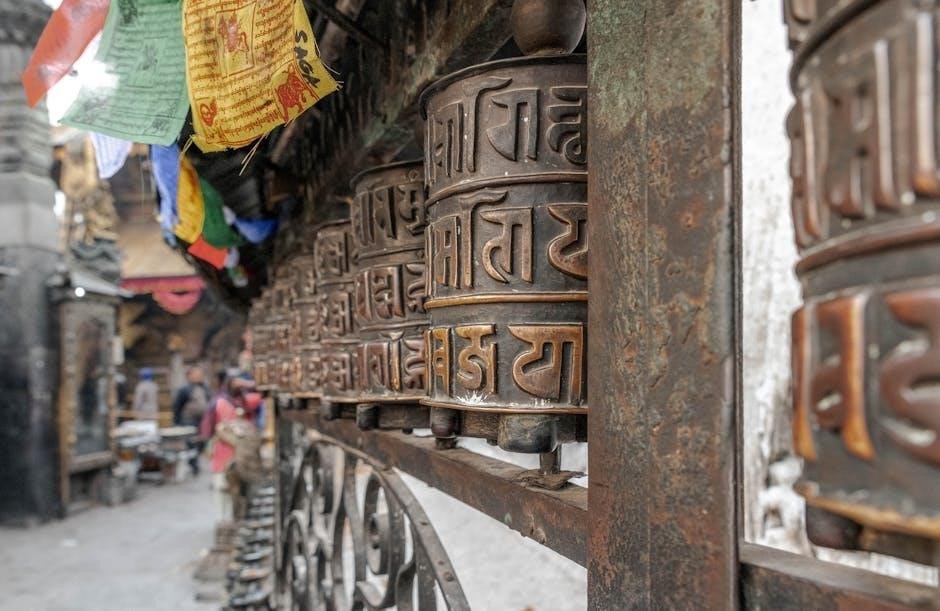
Structure and Verses
The Argala Stotram consists of a specific number of verses, each crafted to invoke Goddess Durga’s blessings․ Its poetic structure emphasizes devotion and divine connection, blending spiritual themes seamlessly․
Number of Verses in the Argala Stotram
The Argala Stotram is a revered Sanskrit hymn dedicated to Goddess Durga, comprising approximately 28 verses․ These verses are intricately composed in poetic meter, reflecting divine praise and supplication․ Each verse serves as a heartfelt prayer, seeking the goddess’s blessings, protection, and guidance․ The stotram is structured to invoke Durga’s various forms, emphasizing her omnipotence and benevolence․ Its verses are deeply rooted in Hindu scripture, particularly the Durga Saptashati, and are often recited during rituals and ceremonies․ The precise number of verses ensures a balanced and focused worship experience, making it accessible for devotees to recite and meditate upon․
Purpose and Meaning of Each Verse
The Argala Stotram’s verses are meticulously crafted to invoke Goddess Durga’s blessings and protection․ Each verse serves a specific purpose, such as praising her divine attributes, seeking refuge, or requesting guidance․ The hymn emphasizes the goddess’s role as a remover of obstacles and a granter of spiritual and material prosperity․ Many verses symbolize the devotee’s surrender to her divine will, while others highlight her fierce yet nurturing nature․ The stotram’s verses are designed to evoke deep devotion, ensuring the reciter connects with Durga on a personal and spiritual level․ This sacred text is a powerful tool for spiritual growth and divine connection․
Specific Verses and Their Interpretations
Certain verses in the Argala Stotram hold profound significance, offering insights into Goddess Durga’s divine attributes․ For instance, the fifth verse glorifies her cosmic form, symbolizing her omnipresence and power to transcend worldly boundaries․ The tenth verse emphasizes her role as a protector, seeking refuge from negative energies and obstacles․ These verses are often interpreted as a devotee’s plea for guidance and strength․ They also reflect the duality of the goddess—fierce yet nurturing, destroyer of evils yet bestower of grace․ Each verse is a meditation on her divine qualities, encouraging devotees to seek her blessings for both spiritual growth and worldly success․ The stotram’s verses are deeply symbolic, making them a focal point of worship and reflection․

Deities and Aspects
The Argala Stotram is dedicated to Goddess Durga, invoking her various forms and aspects․ It praises her as the remover of obstacles and granter of boons, embodying cosmic energy․
Dedication to Goddess Durga
The Argala Stotram is profoundly dedicated to Goddess Durga, celebrating her divine power and benevolence․ It extols her as the universal mother, embodying both fierce protection and nurturing grace․ The stotram, often recited alongside the Durga Saptashati, serves as a devotional bridge, connecting the devotee to Durga’s cosmic energy․ Each verse reverberates with praise for her victories over darkness and chaos, symbolizing her role as a protector․ By invoking her various forms, the stotram seeks her blessings for strength, wisdom, and liberation․ Its dedication highlights Durga’s supremacy in Hindu spirituality, making it a cherished hymn for those seeking her divine guidance and protection․
Invocation of Different Forms of the Goddess
The Argala Stotram intricately invokes various forms of Goddess Durga, each embodying distinct energies and attributes․ It reveres her as Mahakali, the destroyer of negativity, Maha Lakshmi, the bestower of wealth, and Maha Saraswati, the granter of knowledge․ These forms symbolize her multifaceted nature, ensuring protection, prosperity, and wisdom․ By addressing these aspects, devotees seek her blessings for both material and spiritual success․ The stotram’s verses meticulously acknowledge these divine manifestations, making it a powerful tool for worship and rituals, ensuring her grace is invoked in all her glorious forms, thus amplifying the hymn’s efficacy in fulfilling desires and overcoming challenges․
Blessings and Powers Associated with the Stotram
The Argala Stotram is believed to hold immense spiritual and material blessings, offering protection, prosperity, and victory․ It is said to ward off negative energies, obstacles, and misfortunes, while also granting strength and courage․ Devotees believe that reciting the stotram with faith invokes Goddess Durga’s divine grace, bestowing blessings for success in endeavors, harmony in life, and liberation from suffering․ Its verses are considered powerful tools for spiritual growth, enabling devotees to connect with the divine feminine energy․ Regular recitation is thought to enhance mental clarity, emotional balance, and inner peace, ultimately leading to a fulfilling and enlightened life․

Recitation and Rituals
The Argala Stotram is typically recited during auspicious times, such as early morning or evening, with proper rituals like purification, offerings, and meditation to invoke divine blessings․
Best Times for Reciting the Argala Stotram
The ideal times for reciting the Argala Stotram are during the early morning hours, known as Brahma Muhurta, or in the evening after sunset․ These periods are considered sacred and conducive for spiritual practices․ Additionally, reciting the stotram during Navratri, a nine-day festival dedicated to Goddess Durga, amplifies its effects․ Fridays and Tuesdays are also auspicious days, as they are associated with the worship of the divine feminine․ Many devotees also recite it during the lunar phases of Amavasya (new moon) and Purnima (full moon) for enhanced spiritual benefits․ Consistency in recitation is key to experiencing its profound impact․
Rituals Accompanying the Recitation
Recitation of the Argala Stotram is often accompanied by specific rituals to enhance its spiritual efficacy․ Devotees typically begin by lighting a lamp and offering incense to Goddess Durga․ Placing flowers at the altar and maintaining a clean, sacred space is considered essential․ Many practitioners use a rudraksha mala to count the verses, ensuring focus and devotion․ The stotram is ideally recited 11 or 21 times for optimal benefits․ Some traditions also involve offering food or prasad to the deity before consumption․ These rituals create a conducive environment for connecting with the divine energy, amplifying the stotram’s blessings and protective powers․ Consistency in practice is highly recommended for desired results․
Importance of Chandi Path and Durga Saptashati
The Chandi Path and Durga Saptashati hold profound significance as foundational texts in Hindu spirituality․ The Argala Stotram is an integral part of the Durga Saptashati, which narrates the divine exploits of Goddess Durga․ Chandi Path, a rhythmic recitation of the Saptashati, is believed to invoke the goddess’s protective and nurturing energies․ Together, these texts are recited during Navaratri and other sacred occasions to seek divine blessings and spiritual growth․ Their verses embody the essence of divine power, offering protection, courage, and wisdom to devotees․ Regular recitation is considered a powerful practice for overcoming life’s challenges and attaining inner peace․ These scriptures remain central to Hindu worship and devotion․
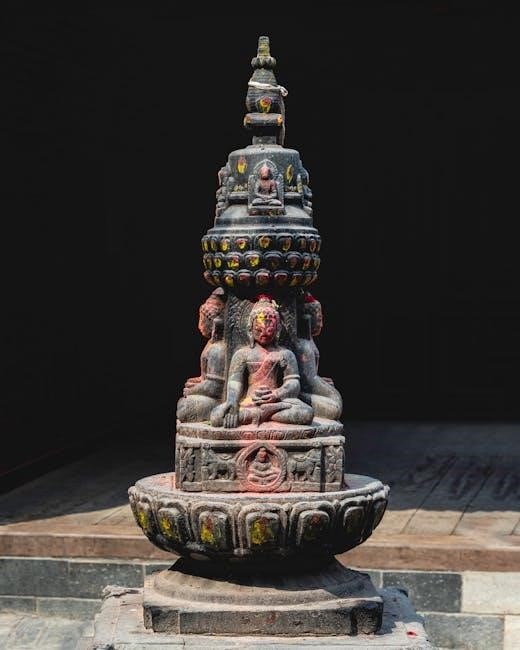
Benefits and Effects
Argala Stotram offers spiritual upliftment, protection from negativity, and fulfillment of desires․ It enhances positive energy, grants courage, and helps overcome adversity, fostering peace and prosperity in life․
Spiritual and Material Benefits
The Argala Stotram is revered for its profound spiritual and material benefits․ It is believed to grant devotees inner peace, mental clarity, and a deep connection to Goddess Durga․ Spiritually, it helps in purifying the soul, enhancing devotion, and attaining divine grace․ Materialistically, it is said to fulfill desires, bestow prosperity, and ensure success in endeavors․ Reciting the stotram is thought to remove financial hardships, foster stability, and attract positive energies․ It also strengthens one’s courage and resilience, enabling them to overcome life’s challenges․ By chanting this sacred hymn, devotees can experience both spiritual enlightenment and worldly success, leading to a balanced and fulfilling life․
Removal of Obstacles and Negative Energies
The Argala Stotram is highly effective in dispelling obstacles and negative energies, offering protection and relief to devotees․ By invoking Goddess Durga’s powerful forms, the stotram creates a shield against adversities, misfortunes, and evil forces․ It is believed to eliminate emotional and mental blockages, fostering a harmonious and peaceful life․ Regular recitation of the Argala Stotram is said to cleanse the environment of negative vibrations, promoting positivity and clarity․ This sacred hymn is particularly potent during challenging times, aiding in overcoming difficulties and restoring balance․ Its divine energy helps in cutting through karmic bonds and impediments, ensuring a smoother path toward personal and spiritual growth․
Prosperity and Victory Through the Stotram
The Argala Stotram is renowned for its ability to bestow prosperity and victory upon those who recite it with devotion; By invoking Goddess Durga’s divine blessings, the stotram helps individuals overcome challenges and achieve success in their endeavors․ It is believed to attract positive energies, ensuring material prosperity and spiritual growth․ The stotram’s verses are designed to grant courage and determination, enabling devotees to triumph over adversity․ Regular recitation is said to bring harmony, wealth, and fulfillment, while also fostering a sense of purpose and divine connection․ Many followers credit the Argala Stotram for its transformative power in securing victory and prosperity in both personal and professional realms․
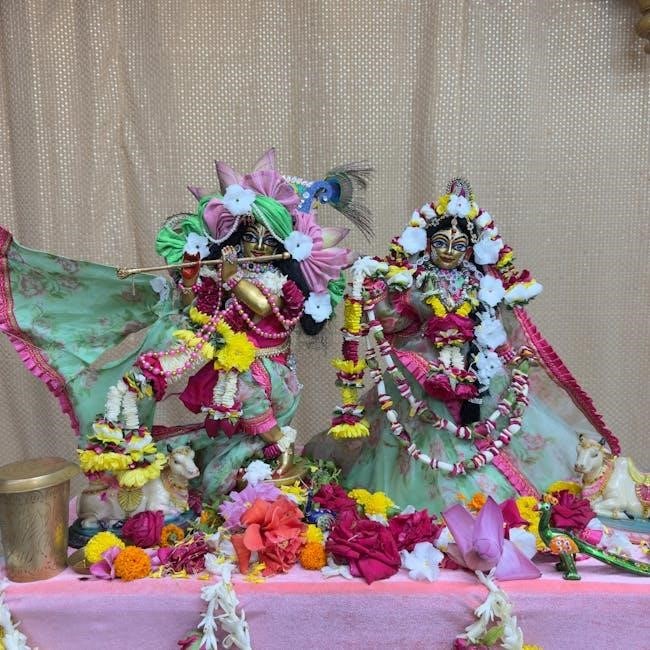
Translations and Availability
Argala Stotram is widely available in PDF formats, primarily in Sanskrit, offering devotees easy access for recitation and study․ Translations in English and Hindi are also popular, catering to diverse audiences and ensuring the stotram’s universal reach․ Many spiritual websites and platforms provide free downloads, making it convenient for seekers to embrace its divine wisdom and blessings․
PDF Versions of the Argala Stotram in Sanskrit
The Argala Stotram is readily available in PDF format, particularly in its original Sanskrit version, ensuring accessibility for devotees worldwide․ These PDFs are often found on spiritual websites, religious portals, and e-book platforms, offering clean and well-formatted versions of the stotram․ Many of these documents include diacritical marks, making it easier for non-native speakers to recite accurately․ Additionally, some PDFs are accompanied by recitation guides or audio links, enhancing the user experience․ Devotees can download these files for free or purchase them from trusted sources, ensuring they receive authentic and error-free versions of the sacred text․
Translations in Other Languages
While the Argala Stotram is originally composed in Sanskrit, translations in other languages, such as English, Hindi, and regional Indian languages, are widely available․ These translations aim to make the stotram accessible to a broader audience, ensuring its spiritual message reaches devotees worldwide․ Many websites and religious platforms offer downloadable PDFs with English translations alongside the Sanskrit text, facilitating easier understanding and recitation․ These translations often retain the poetic essence and spiritual significance of the original, helping devotees connect deeply with the divine energy of Goddess Durga․ The availability of translations has made the Argala Stotram a global spiritual resource․
Online Resources and Downloads
The Argala Stotram in Sanskrit is readily available online, with numerous websites offering free PDF downloads․ Religious and spiritual platforms provide downloadable versions, often accompanied by English translations for better understanding․ E-book platforms like Google Books and archive sites also host PDF versions of the stotram․ Additionally, mobile apps dedicated to Hindu scriptures include the Argala Stotram for easy access․ Many forums and communities share links to high-quality PDFs, ensuring that devotees can easily obtain and recite the stotram․ These online resources have made it convenient for global audiences to access and benefit from this sacred hymn․
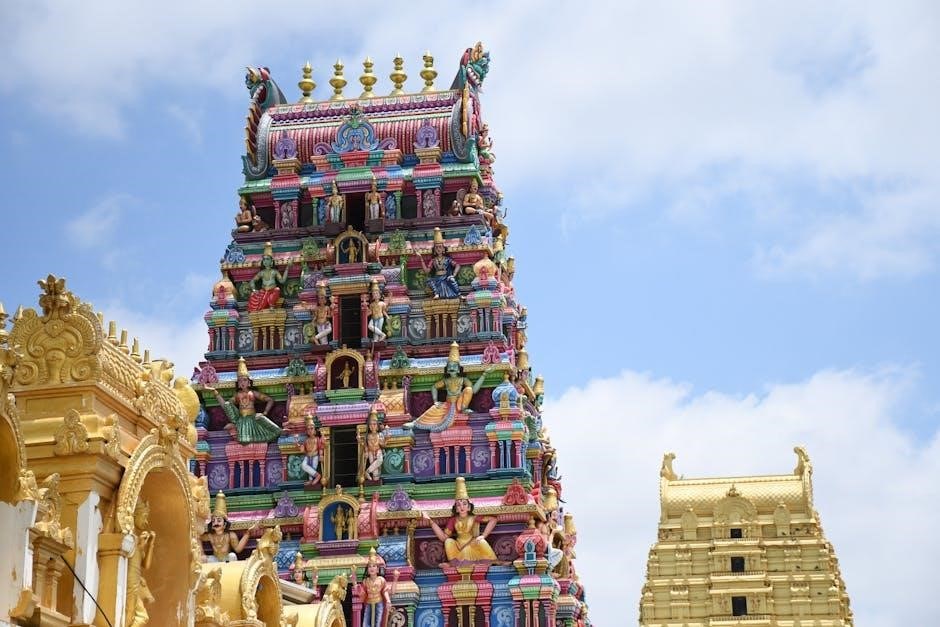
Cultural and Spiritual Significance
The Argala Stotram holds deep cultural and spiritual significance, being a revered hymn in Hindu tradition, often recited during ceremonies to invoke Goddess Durga’s blessings and protection․
Role in Hindu Festivals and Ceremonies
The Argala Stotram plays a vital role in Hindu festivals, particularly during Navratri and Durga Puja, where it is chanted to honor Goddess Durga’s divine power and grace․ It is often recited alongside the Durga Saptashati, creating a sacred ambiance that connects devotees to the divine feminine energy․ During these ceremonies, the stotram is believed to invoke blessings, protection, and victory over adversities․ Many temples and households include it in their puja rituals, especially during the ninth day of Navratri, symbolizing surrender to the goddess․ Its recitation is also common in cultural processions and community gatherings, fostering spiritual unity and celebration․ This practice strengthens faith and ensures prosperity, making it an integral part of Hindu religious and cultural traditions․
Impact on Devotees and Worship Practices
The Argala Stotram deeply influences devotees by fostering a sense of spiritual connection and inner peace․ Many believers report feeling empowered and protected after reciting the stotram, as it is believed to ward off negative energies and obstacles․ It strengthens devotion and faith, encouraging followers to embrace Goddess Durga’s divine attributes of courage and strength․ The stotram is often incorporated into daily worship routines, enhancing the depth of spiritual practices․ Its recitation during pujas and meditation fosters a tranquil mindset, helping devotees align with their inner selves․ This sacred hymn not only enriches worship but also inspires a lifestyle rooted in divine reverence and positivity․
Connection to Yoga and Indian Philosophy
The Argala Stotram resonates deeply with the principles of yoga and Indian philosophy, particularly through its emphasis on spiritual growth and self-realization; The stotram aligns with the concept of Bhakti Yoga, fostering devotion and surrender to the divine feminine energy embodied by Goddess Durga․ Its verses inspire meditation and introspection, helping practitioners connect with their inner self․ Rooted in Vedic and Tantric traditions, the stotram reflects the philosophical ideals of unity and liberation․ By reciting it, devotees embody the essence of Indian philosophy, seeking harmony between the individual self and the universal consciousness․ This sacred hymn bridges devotion and philosophy, enriching both spiritual and yogic practices․
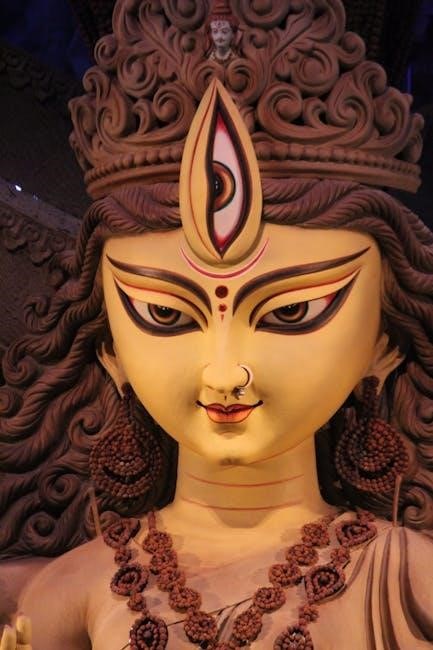
Related Stotras and Mantras
The Argala Stotram is often recited alongside other sacred hymns like the Devi Kavacham, Kilaka Stotram, and Navdurga Mantra, enhancing its spiritual significance and devotion․
Devi Kavacham and Kilaka Stotram
Devi Kavacham and Kilaka Stotram are sacred hymns often recited alongside the Argala Stotram, enhancing its spiritual potency․ The Devi Kavacham, or “Armour of the Goddess,” is a protective prayer invoking Goddess Durga’s shield against adversity․ Similarly, the Kilaka Stotram focuses on the power of divine invocation, emphasizing the removal of obstacles․ Both stotras complement the Argala Stotram by deepening the connection with the divine feminine energy․ Together, they create a holistic worship experience, offering protection, clarity, and empowerment․ These stotras are integral to Navratri and Durga Puja rituals, fostering spiritual growth and devotion among followers․
Devi Mahatmyam and Its Stotras
Devi Mahatmyam, also known as the Durga Saptashati, is a foundational text in Hindu scripture that glorifies Goddess Durga․ It is divided into 700 verses across 13 chapters, detailing the divine deeds of the Goddess․ The Argala Stotram is an integral part of this text, often recited during Navratri and other devotional ceremonies․ Devi Mahatmyam is revered for its spiritual and philosophical depth, offering insights into the nature of the divine feminine․ Its stotras, including the Argala Stotram, are believed to bestow immense spiritual and material benefits, empowering devotees with courage, wisdom, and protection․ The text remains a cornerstone of Goddess worship in Hindu tradition․
Shiva-Krita Mantra Raja Pada Stotram
The Shiva-Krita Mantra Raja Pada Stotram is a revered hymn attributed to Lord Shiva, praising Goddess Durga’s divine glory․ It is part of the Durga Saptashati, a sacred text in Hinduism․ This stotram is known for its profound spiritual significance, often recited by devotees to seek the Goddess’s blessings and protection․ Comprising 16 verses, it extols Durga’s various forms and virtues․ The stotram is believed to grant spiritual enlightenment and material prosperity when recited with devotion․ It is frequently chanted alongside the Argala Stotram during Navratri and other auspicious occasions․ Its availability in PDF formats in Sanskrit has made it accessible for widespread worship and study․

Modern Interpretations and Uses
The Argala Stotram is widely used in contemporary meditation practices, offering spiritual solace․ Its digital availability has enhanced accessibility for global devotees, fostering deeper connection and devotion․
Contemporary Recitations and Performances
Modern devotees incorporate the Argala Stotram into daily routines and special events, blending tradition with innovation․ Live streams and social media platforms showcase its recitation by priests and devotees worldwide, enhancing accessibility․ Cultural events and temple ceremonies often feature melodious renditions, attracting both young and old․ The stotram’s rhythmic verses are sometimes set to contemporary music, making it appealing to new generations․ Digital platforms like YouTube and meditation apps host guided recitations, facilitating easy learning․ This blend of traditional spirituality with modern technology ensures its enduring relevance․ The stotram’s universal appeal continues to inspire fresh interpretations while preserving its sacred essence․
Use in Meditation and Spiritual Practices
The Argala Stotram is widely used in meditation and spiritual practices to foster inner peace and divine connection․ Devotees recite its verses to calm the mind, focus intentions, and seek blessings from Goddess Durga․ Many practitioners incorporate it into their daily rituals, often during sunrise or sunset, to align with sacred energies․ The stotram’s rhythmic chants are believed to harmonize the mind-body-soul connection, aiding in stress relief and emotional balance․ Meditation sessions often begin with its recitation to create a conducive environment for deeper spiritual reflection․ Its verses are also chanted during yoga practices to enhance focus and spiritual growth, making it a versatile tool for holistic well-being․
Popularity in Digital Media and Platforms
The Argala Stotram has gained significant popularity in digital media, with numerous platforms offering its Sanskrit PDF versions for free download․ Websites like [specific sites] provide easy access to the text, catering to devotees worldwide․ Audio versions are widely available on YouTube, Spotify, and other streaming platforms, making it accessible for daily recitation․ Mobile apps dedicated to Hindu scriptures also feature the Argala Stotram, allowing users to download and recite it conveniently․ Social media platforms and forums actively share its benefits, fostering a community of devotees․ This digital presence has ensured the stotram’s reach to a global audience, preserving its cultural significance․
The Argala Stotram is a revered hymn, offering spiritual and material blessings․ Its widespread availability in Sanskrit PDFs and digital formats has made it accessible globally, inspiring devotion and transforming lives․
Final Thoughts on the Argala Stotram
The Argala Stotram embodies the essence of devotion and empowerment, offering followers a profound connection to Goddess Durga․ Its verses, rich in spiritual wisdom, guide seekers toward courage, wisdom, and victory․ Available in Sanskrit PDFs, it remains a vital resource for those seeking enlightenment and strength․ Reciting it with faith fosters resilience and positivity, making it a timeless treasure in Hindu spirituality․ Embrace the Argala Stotram to experience its transformative power and deepen your spiritual journey․
Encouragement for Further Study and Practice
Exploring the Argala Stotram in its Sanskrit PDF form offers a deeper connection to its spiritual essence․ Delve into its verses to uncover the rich symbolism and divine energy they embody․ Regular recitation fosters inner peace and strength, while understanding its context enhances devotion․ Embrace this sacred text as a guide for personal growth and spiritual evolution․ By immersing yourself in its wisdom, you can experience profound transformations and align with the divine feminine energy it celebrates․ Let the Argala Stotram illuminate your path toward enlightenment and empowerment․
